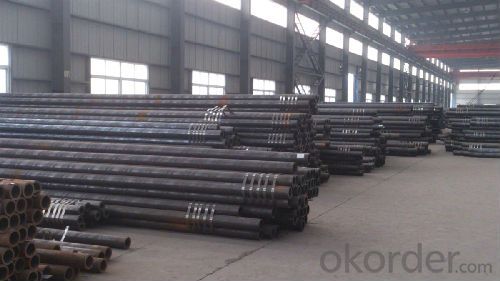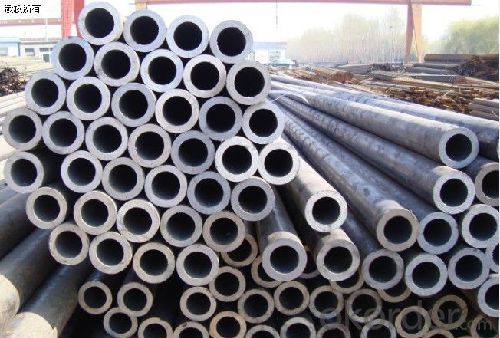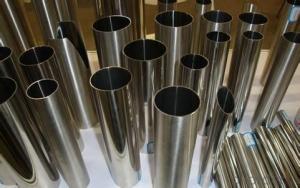ASME API 5L High Quality Stainless Steel Pipe
- Loading Port:
- Tianjin
- Payment Terms:
- TT or LC
- Min Order Qty:
- 25 m.t.
- Supply Capability:
- 10000 m.t./month
OKorder Service Pledge
OKorder Financial Service
You Might Also Like
We are company that have many years experience and professional manager team and engineer team and sales team, sure we will provide you high quality of pipe and professioanl service.
Seamless pipe possesses a hollow section and without seam around the strip steel. It is made with solid bar or steel ingot by perforating machine. As the facture process does not include any welding, seamless pipes are considered to be stronger and more durable. Generally speaking, seamless pipe has better pressure resistance and security than other classifications, and was usually more easily available than welded pipe.
2、Main Features of the Seamless Pipe:
• High working accuracy
• High strength
• Small inertia resistance
• Strong therming dissipine ability
• Good appearance
• Reasonble price
3、Seamless Pipe Specification:
Standard | GB, DIN, ASTM ASTM A106-2006, ASTM A53-2007 |
Grade | 10#-45#, 16Mn 10#, 20#, 45#, 16Mn |
Thickness | 8 - 33 mm |
Section Shape | Round |
Outer Diameter | 133 - 219 mm |
Place of Origin | Shandong, China (Mainland) |
Secondary Or Not | Non-secondary |
Application | Hydraulic Pipe |
Technique | Cold Drawn |
Certification | API |
Surface Treatment | factory state or painted black |
Special Pipe | API Pipe |
Alloy Or Not | Non-alloy |
Length | 5-12M |
Outer Diameter | 21.3-610mm |
Grade | 20#, 45#, Q345, API J55, API K55, API L80, API N80, API P110, A53B |
Standard | ASME, ASTM |
1) Material:20#(ASTM A 106/A53 GRB.API5LGRB,GB),45#,16Mn,10#.
2) Specification range: OD: 21.3-610mm, WT:6-70mm, length:6-12m or according to the requirement of clients.
3) Executive standards: GB, ASME API5L.ASTM A 106/A53,Despite of the above standards, we can also supply seamless steel pipe with standard of DIN, JIS, and so on, and also develop new products according to the requirements of our clients!
4) Surface: black lacquered, varnish coating or galvanized.
5) Ends: Beveled or square cut, plastic capped, painted.
6) Packing: bundles wrapped with strong steel strip, seaworthy packing.
4、Packaging & Delivery:
Packaging Details: | seaworthy package, bundles wrapped with strong steel strip |
Delivery Detail: | 15-30days after received 30%TT |
5、FAQ of Seamless Pipe:
①How is the quality of your products?
We have many years business experience in this area, and we have professional engineer and manager team and sure we can provide you high quality production and professional service.
②How about price?
Yes, we are factory and be able to give you lowest price below market one, and we have a policy that “ for saving time and absolutely honest business attitude, we quote as lowest as possible for any customer, and discount can be given according to quantity”,if you like bargain and factory price is not low enough as you think, just don’t waste your time.Please trust the quotation we would give you, it is professional one.
③Why should you chose us?
We can give you both.Additionally, we can also offer professional products inquiry, products knowledge train(for agents), smooth goods delivery, exellent customer solution proposals.Our service formula: good quality+good price+good service=customer’s trust
SGS test is available, customer inspection before shipping is welcome, third party inspection is no problem.
6、Seamless Pipe Images:


- Q:What are the common types of fittings used with stainless steel pipes?
- There are several common types of fittings used with stainless steel pipes. Some of the most commonly used fittings include: 1. Stainless Steel Threaded Fittings: These fittings have threaded ends that allow them to be easily connected to pipes or other fittings. They are typically used in low-pressure applications and can be easily installed or removed using a wrench. 2. Stainless Steel Butt-Weld Fittings: Butt-weld fittings are used to connect stainless steel pipes with a seamless method. These fittings are welded directly to the pipe, providing a strong and leak-free connection. Butt-weld fittings are commonly used in high-pressure or high-temperature applications. 3. Stainless Steel Flanges: Flanges are used to connect pipes or fittings together by bolting them together. They provide a secure and rigid connection that can be easily disassembled when needed. Flanges are available in various types such as slip-on, weld neck, socket weld, and blind flanges. 4. Stainless Steel Compression Fittings: Compression fittings are used to create a tight seal between pipes by compressing a ferrule against the pipe. They are commonly used in plumbing systems and provide a reliable and leak-free connection. 5. Stainless Steel Camlock Fittings: Camlock fittings are quick-connect fittings that are commonly used in industrial applications. They have a male and female end that can be easily connected by simply pushing them together and then locking them in place. Camlock fittings are known for their ease of use and versatility. Overall, these are some of the common types of fittings used with stainless steel pipes. The choice of fitting depends on the specific application, pressure, temperature, and other factors. It is important to select the right fitting to ensure a secure and reliable connection.
- Q:Can stainless steel pipes be insulated with polystyrene?
- Yes, stainless steel pipes can be insulated with polystyrene. Polystyrene is a commonly used insulation material due to its thermal properties and ability to resist moisture. It can effectively reduce heat transfer and prevent condensation on the surface of the pipe. However, it is important to ensure that the polystyrene insulation is properly sealed and protected to avoid any degradation or damage to the stainless steel pipe.
- Q:How do you calculate the heat transfer coefficient of stainless steel pipes?
- The heat transfer coefficient of stainless steel pipes can be calculated using various methods, including empirical correlations and theoretical calculations. One commonly used empirical correlation is the Dittus-Boelter equation, which relates the heat transfer coefficient to the Reynolds number and Prandtl number. The Dittus-Boelter equation is given by: Nu = 0.023 * Re^0.8 * Pr^0.4 Where Nu is the Nusselt number, Re is the Reynolds number, and Pr is the Prandtl number. The Nusselt number represents the ratio of convective to conductive heat transfer and is dimensionless. To calculate the Reynolds number, use the following formula: Re = (ρ * v * D) / μ Where ρ is the density of the fluid, v is the velocity of the fluid, D is the hydraulic diameter of the pipe, and μ is the dynamic viscosity of the fluid. The Prandtl number can be determined using the following equation: Pr = μ * Cp / k Where Cp is the specific heat capacity of the fluid and k is the thermal conductivity of the fluid. Once the Reynolds and Prandtl numbers are determined, substitute them into the Dittus-Boelter equation to calculate the Nusselt number. Finally, the heat transfer coefficient can be obtained by multiplying the Nusselt number with the thermal conductivity of the fluid and dividing it by the hydraulic diameter of the pipe: h = (Nu * k) / D Where h is the heat transfer coefficient. It is important to note that these calculations are based on assumptions and empirical correlations, and actual heat transfer coefficients may vary depending on various factors such as pipe roughness, fluid properties, and flow conditions. Therefore, it is recommended to consult relevant heat transfer literature or conduct experimental studies for more accurate results.
- Q:Can stainless steel pipes be used in the construction industry?
- Yes, stainless steel pipes can be used in the construction industry. Stainless steel offers many advantages, making it a preferred choice for various construction applications. Firstly, stainless steel pipes have excellent corrosion resistance, which is essential in construction projects that involve exposure to moisture, chemicals, or extreme weather conditions. This resistance to corrosion ensures the longevity and durability of the pipes, reducing maintenance and replacement costs. Furthermore, stainless steel pipes have high strength and impact resistance, making them suitable for structural applications in buildings, bridges, and other construction projects. Their strength allows for the transportation of fluids and gases under high pressure, making them ideal for plumbing and HVAC systems. Stainless steel pipes are also highly hygienic and resistant to bacteria growth, making them suitable for applications in the food and beverage industry, hospitals, and laboratories. They are easy to clean and maintain, ensuring the safety and purity of the transported materials. Additionally, stainless steel pipes have aesthetic appeal, as they can be polished to a high shine or finished in various colors, making them suitable for architectural purposes. They can be used for handrails, staircases, exterior cladding, and other decorative elements in buildings. Overall, stainless steel pipes are versatile, durable, and corrosion-resistant, making them an excellent choice for the construction industry.
- Q:What are the weight limitations for stainless steel pipes?
- The weight limitations for stainless steel pipes vary depending on several factors such as the grade of stainless steel, the pipe's dimensions, and the intended application. However, stainless steel pipes are known for their strength and durability, which allows them to withstand heavy loads. Generally, stainless steel pipes can support significant weight without deformation or failure. It is important to consult the manufacturer's specifications or engineering standards for precise weight limitations as they can provide the most accurate information specific to the particular type and size of stainless steel pipe being used.
- Q:What are the dimensions and sizes of stainless steel pipes?
- The dimensions and sizes of stainless steel pipes can vary greatly depending on the specific application and industry requirements. Stainless steel pipes are available in various sizes, ranging from small diameter tubes of a few millimeters to larger pipes with diameters exceeding several feet. The dimensions of stainless steel pipes are typically specified by their outer diameter (OD), wall thickness, and length. The wall thickness can vary based on the intended use and pressure requirements of the pipe. Additionally, stainless steel pipes can be found in different shapes, such as round, square, or rectangular, to suit various installation needs.
- Q:What is the difference between sanitary and industrial stainless steel pipes?
- The primary distinction between sanitary and industrial stainless steel pipes lies in their intended purposes and the level of cleanliness needed. Sanitary stainless steel pipes are specifically designed for use in industries such as food and beverage, pharmaceuticals, and other environments where cleanliness and hygiene are crucial. These pipes are manufactured with a higher degree of surface finish, typically smooth and polished, to prevent bacterial growth and ensure easy cleaning. The inner surface of sanitary pipes is often electropolished to further enhance its smoothness and resistance to corrosion. Additionally, sanitary pipes are often equipped with tri-clamp fittings or other sanitary connections to facilitate easy disassembly for cleaning purposes. On the contrary, industrial stainless steel pipes find application in a diverse range of industries, including manufacturing, oil and gas, chemical processing, and construction. These pipes are usually designed to withstand high pressures, extreme temperatures, and harsh environments. Industrial pipes may have a rougher surface finish and may not require the same level of cleanliness as sanitary pipes. They are often welded or threaded together for assembly and are built to withstand heavy-duty usage. In conclusion, the main differences between sanitary and industrial stainless steel pipes can be found in their intended purposes, surface finish, and the level of cleanliness required. Sanitary pipes prioritize hygiene and easy cleaning, making them well-suited for food and pharmaceutical applications. Industrial pipes, on the other hand, focus on durability and strength to endure demanding industrial environments.
- Q:How do you prevent scaling in stainless steel pipes?
- There are several ways to prevent scaling in stainless steel pipes: 1. Regular cleaning and maintenance: One of the most effective preventive measures is to regularly clean the stainless steel pipes. This can be done by using appropriate cleaning agents and techniques that remove any scale buildup or deposits. Additionally, regular inspections can help identify any early signs of scaling, allowing for prompt action. 2. Proper water treatment: Scaling often occurs due to the presence of minerals and impurities in the water. Implementing a suitable water treatment system can help remove or reduce these impurities, preventing scaling in stainless steel pipes. This may involve using water softeners, filtration systems, or chemical treatments based on the specific requirements of the water source. 3. Temperature control: High temperatures can accelerate the scaling process, so it is important to control the temperature of the fluid flowing through the stainless steel pipes. Ensuring that the temperature remains within the recommended range can help minimize the formation of scale deposits. 4. Flow velocity control: Another factor that can contribute to scaling is the flow velocity of the fluid inside the pipes. High flow velocities can cause turbulence, leading to increased scale formation. By controlling the flow velocity within the recommended limits, the risk of scaling can be reduced. 5. Material selection: In some cases, the choice of stainless steel grade can impact the likelihood of scaling. Certain grades of stainless steel are more resistant to scaling than others. Consulting with experts or professionals in the field can help in selecting the appropriate stainless steel grade that is less prone to scaling. It is important to note that each situation may have unique considerations, and it is advisable to consult with professionals or specialists in the field to determine the most suitable preventive measures for specific applications.
- Q:What are the different types of fittings used with stainless steel pipes?
- Stainless steel pipes can be paired with various types of fittings, depending on the specific needs and application. Here are some of the most commonly used fittings: 1. Compression fittings: These fittings create a tight, leak-proof connection by compressing a ferrule onto the pipe. They work well with both rigid and flexible stainless steel pipes and are easy to install. 2. Threaded fittings: Known as screwed fittings, these have female threads that can be screwed onto the male threads of the pipe. They are commonly used in low-pressure situations and can be easily installed or removed. 3. Butt weld fittings: These fittings are used to make a permanent, welded connection between two stainless steel pipes. The pipes need to be beveled to create a V-shaped groove, and they are typically used in high-pressure or high-temperature settings. 4. Flange fittings: Flanges are utilized to connect two stainless steel pipes or connect a pipe to a valve, pump, or other equipment. They provide a strong and leak-proof connection and can be bolted or welded onto the pipe. 5. Push-to-connect fittings: These fittings offer a quick and tool-free connection. They use a push-in mechanism to secure the pipe and are commonly used in plumbing and air compression systems. 6. Camlock fittings: Camlock fittings enable rapid connection and disconnection of hoses and pipes. They have a lever or cam mechanism that locks the fitting into place, ensuring a secure connection. These fittings are often used in industrial settings where frequent connections and disconnections are necessary. Ultimately, the choice of fitting depends on factors such as the application, pressure requirements, and ease of installation. It is crucial to select the appropriate fitting to guarantee a reliable and long-lasting connection for stainless steel pipes.
- Q:What are the common shapes of stainless steel pipes?
- The common shapes of stainless steel pipes include round, square, and rectangular.
1. Manufacturer Overview |
|
|---|---|
| Location | |
| Year Established | |
| Annual Output Value | |
| Main Markets | |
| Company Certifications | |
2. Manufacturer Certificates |
|
|---|---|
| a) Certification Name | |
| Range | |
| Reference | |
| Validity Period | |
3. Manufacturer Capability |
|
|---|---|
| a)Trade Capacity | |
| Nearest Port | |
| Export Percentage | |
| No.of Employees in Trade Department | |
| Language Spoken: | |
| b)Factory Information | |
| Factory Size: | |
| No. of Production Lines | |
| Contract Manufacturing | |
| Product Price Range | |
Send your message to us
ASME API 5L High Quality Stainless Steel Pipe
- Loading Port:
- Tianjin
- Payment Terms:
- TT or LC
- Min Order Qty:
- 25 m.t.
- Supply Capability:
- 10000 m.t./month
OKorder Service Pledge
OKorder Financial Service
Similar products
New products
Hot products
Related keywords



























